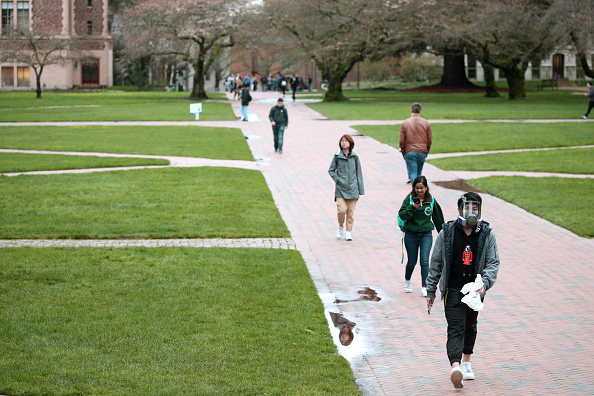You have /5 articles left.
Sign up for a free account or log in.

Students at the University of Washington
Karen Ducey/Getty Images
As the new coronavirus infects and kills more people in the United States, several West Coast universities, including the University of Washington and Stanford University, have chosen to forgo in-person classes in favor of remote learning.
The University of Washington announced its transition on Friday morning, and Stanford announced its on Friday evening. Both begin Monday and will continue for the rest of quarter. University of Washington officials have said that pending guidance from public health agencies, they plan to go back to face-to-face instruction at the start of the spring quarter, March 30. Brandman University, Seattle University and the Seattle campus of Northeastern University have also moved to remote instruction for the time being.
The decision to transition classes is part of an attempt at “social distancing,” the practice of limiting large gatherings and in-person contact to slow the transmission of the virus, called SARS-CoV-2.
“The issue is not only how do we stop this epidemic, but how can we slow it down so our health-care system can respond,” said UW president Ana Mari Cauce at a press conference Friday.
Faculty will be mostly responsible for making the decisions about how to move their classes to remote learning.
The Decision to ‘Close’
Cauce emphasized that while classes will be moving out of classrooms, the university’s three campuses will not be closed. Hospital operations, scientific research and food service will all continue, and students will be allowed to stay in dorms and residences.
“We have some students here for whom travel to their home is not possible,” Cauce said. She noted that although the virus is most dangerous for older people and those with chronic illnesses, some students may still fall into those categories. Students in risk groups, she said, were already not attending class.
The University of Washington enrolls over 50,000 students, a majority of whom take classes in person. An online petition posted last week asking the university to close gathered over 20,000 signatures.
The university separately announced that a staff member has received a “presumptive” positive test for the coronavirus but emphasized that the decision to end in-person classes was made before this revelation. Four students have also taken tests for the coronavirus, but those tests have come back negative, officials said.
Denzil Suite, vice president of student affairs at UW, said open bar areas in dining halls, such as salad bars, are being transitioned to a “grab and go” model. Cleaning and sanitizing in student residences have been doubled.
Cauce was emphatic on Friday that the virus and the university’s response to it would have financial consequences, but those would be dealt with and worried about later.
“We are going to make our decision based on what is right,” she said.
Joseph Janes, a professor of library and information science and chair of the UW Faculty Senate, said the administration has handled the situation well considering the circumstances.
“So often, particularly in higher ed, we think, ‘What are our peer institutions going to do?’” he said. “This is an instance where we really had nowhere to turn.”
Janes said that for the majority of faculty, the decision to cancel in-person classes likely came as a surprise. But generally, the administration has done a good job keeping faculty leadership informed and consulted, he said.
“There’s been a sort of rising sense of uncertainty and anxiety about what was going to happen,” Janes said. “I think this is going to provide certainty for people.”
Teaching in an Epidemic
Janes said the administration has left the decision about exactly how to move classes online, or whether it's worth at all trying, up to each individual faculty member.
“There are so many different kinds of classes, there’s no way to do a one-size-fits-all,” he said. “There are some classes where I can imagine its just really hard to go forward.”
With few days left in the quarter, Janes said that many instructors have nearly finished covering their material. For remaining content, instructors have full agency to decide if they would like to hold lectures over videoconferencing, record instructional videos or try some other modality. Final exams could be transitioned to take-home tests or projects.
For classes that involve use of labs, performances or studios, none of those measures may really work. Faculty can choose then to simply grade students on the work they’ve already completed.
Grading students only on the first 80 percent of the semester raises questions of fairness for instructors who built a large and important final assessment into the syllabus and student grading schemes, Janes said, but the decision still remains with the instructors. They can also choose to grade students pass-fail.
Brandman University, which announced a similar transition, teaches about 85 percent of its credit hours online. That makes the transition easier since the infrastructure is already there, said Jennifer Murphy, Brandman’s associate vice chancellor for instructional innovation.
The Brandman classes that do meet in person are still based in Brandman’s learning management system and only meet for one three-hour session per week, she said. These are called blended courses, as much of the course is still completed online. The in-person sessions for those blended courses have been moved to the videoconferencing tool Zoom.
“We are capable of doing this with a low detrimental effect,” Murphy said. “When looking at that versus potentially allowing students, faculty, staff to become ill because something happens, it seems like we are able to do this, so why wouldn’t we?”
The university has increased Zoom trainings for instructors and allowed them to request a staff member from the academic innovation office to sit in on a class if they are nervous about the technology.
The movement to online has raised questions for some universities about exactly how much they are capable of with their existing technology.
“If you don’t have an LMS that’s robust or you don’t have courses built already in an LMS, that’s a huge lift,” Murphy said. “Depending on what things you already have in place, it could be a very difficult process.”
Several universities have been circulating guidance to faculty about how to teach via online methods during an emergency. Guidance from the University of California, Los Angeles, to faculty noted that the administration has purchased more licenses for Zoom. The university also drew attention to a lockdown browser available for faculty to use during assessments, which provides a full audio and video recording of the test attempt.
Faculty have similarly been circulating their own guidance to peers about how to teach online on the fly, sometimes with step-by-step instructions. Instructional design and technology administrators have emphasized that temporarily moving in-person classes to remote learning is different from designing and developing a course that is completely online.
“Teaching well online requires a much more intentional arc of planning and learning around design and pedagogy,” Penelope Adams Moon, director of online learning strategy at UW’s Bothell campus, posted on Twitter. “We need stop-gap measures, but they aren't the same as online teaching.”
Sean Michael Morris, director of the Digital Pedagogy Lab at the University of Colorado at Denver, advised instructors to rethink grading around participation and attendance.
“Asynchronous work is harder than synchronous work,” he said via Twitter. “Assessment should reflect that.”
Morris and others have also emphasized that a transition to online teaching must keep classes accessible for students with disabilities and students who may lack access to the internet or other technology at home.
Megan Raymond, program director at the Western Interstate Commission for Higher Education’s technology cooperative, said that going online might not be right for every institution, depending on how many of its students are already online and other factors.
“There’s a lot of implications that institutions need to evaluate and think through really carefully,” she said, among them whether students have devices that allow them to complete an online course.
She was glad that the University of Washington has decided to keep dining halls and other services open for students, who may be food insecure or similarly vulnerable.
Though moving courses online typically requires an accreditation process, the Department of Education released a letter Thursday morning giving institutions broad approval to use distance technology temporarily to respond to the coronavirus without going through the regular approval process.
As of Friday, Janes hadn’t entirely decided how he was going to move his graduate statistics class over to online.
“We’re in uncharted territory,” he said.








